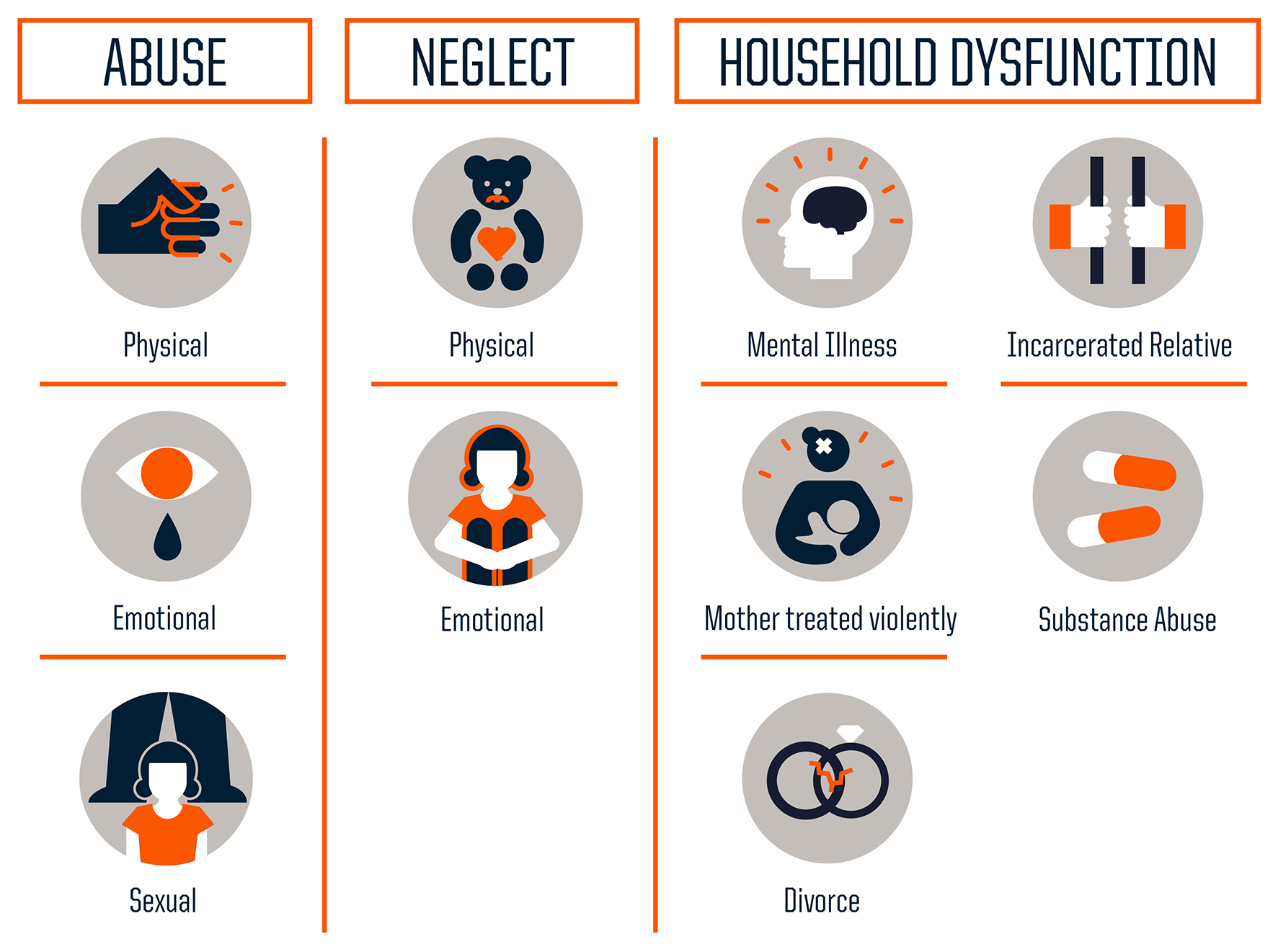MDD: Sociocultural explanations
Sociocultural etiologies of Major Depressive Disorder
The sociocultural approach looks at the role of environmental factors in the onset of depression. This is a more holistic approach to understanding the disorder. In this component, we will look at the role of poverty and adverse childhood experiences. We will also look at the role of culture in the disorder.
Before completing the module below, please read the section of the textbook called the Sociocultural approach to depression. When reading this section, please make note of the following important concepts:
- Adverse Childhood Experiences (ACEs)
- Diathesis-Stress model
- Domino causality
- Explanatory models
- Vulnerability models
The role of environmental factors
Please watch the following video with Nadine Burke Harris. You may have already seen this video if you are also studying the health option. If so, watch it again as a refresher of the concept of Adverse Childhood Experiences [ACEs].
When you have finished, read through the study by Felitti et al (1998) that Burke Harris discusses in the video.

Thinking critically
Try to answer the following questions on your own without looking at the answers. The answers provided are a way for to check your own thinking and learning.
1. What would be the difficulty of applying Burke Harris's plan to give an ACE's inventory to all children coming in for treatment?
There are several potential difficulties. First, as she mentions in the video, a multi-disciplinary team is needed. If a child indicates that there is domestic violence at home or that they are being abused, then social services must assist to address the issue. The physician may know what is happening, but may not have any ability to change it. Another problem is that when a child goes to see a doctor, the parents are in the room. This may mean that children do not feel comfortable sharing such information - either because they are scared of losing their parents or fear of punishment. It may also be that child may be too young to read the questionnaire. Oral presentation of the questions may result in demand characteristics - or the questions may be framed as leading questions resulting in false or exaggerated information from the child.
2. Some have argued that Felitti's original 10 ACE's are culturally or class-biased. What are some examples of Adverse Childhood Experiences that may have been left off the list?
There is no mention of growing up in an unsafe neighborhood - for example, witnessing a crime or feeling threatened in your community (e.g. bullying or criminal gangs). In addition, there is nothing about a refugee's experience - for example, losing one's home, having to flee one's country, or having a parent arrested for political beliefs. Finally, there is nothing about "disasters" - for example, losing your home in a fire or hurricane.
3. Another criticism of using such a list with patients is that it doesn't take into account protective factors. What is meant by this statement?
It means that the data collected does not look at potential factors that could actually prevent high levels of stress, in spite of the adverse experience. These might include having a supportive family, a close friend, a stable financial situation, a good diet, or access to health care or counseling.
Thinking about causality
Why the nature vs nurture debate is over
Before reading through this section, be sure to read the key study by Brown and Harris (1978).
When I was studying psychology, the big debate was always whether behaviour was because of one's "nature" (genetic or other physical causes) or one's "nurture" (environmental and learned behaviour). Today, psychologists no longer have this debate. It is now understood that biological and environmental factors work together to produce behaviour.
Much of mental illness is an example of "domino causality." In simple linear causality, one thing directly makes another thing happen and the effects end there. But it is very common for effects to become causes of new events.
 What is domino causality?
What is domino causality?
- A sequential unfolding of effects over time
- An extended linear pattern that results in direct and indirect effects
- Typically has a clear beginning and a clear ending
- Can be branching where there is more than one effect of a cause (and these may go on to have multiple effects and so on.)
- Branching forms can be traced back to "stem" causes
- Allows researchers to predicted anticipated outcomes and find multiple potential places to intervene in order to prevent a negative outcome.
So, the question is - what is the link between Burke Harris and Brown & Harris, besides that they both have the name "Harris?"
You should notice that a common vulnerability factor for women in Brown and Harris's study was the loss of one's mother before the age of 11. This is an example of an ACE. How is this linked to depression? This is where we need to link the biology and the sociocultural factors.
Domino causality and depression
Researcher Michael Meaney (1988) found that in rats, stress in childhood led to hippocampal cell death and cognitive impairment in old age. More importantly, he found that this was not the result of damage to the hippocampus in the first few weeks of life, but a gradual process caused by an over-active HPA Axis. How did that happen?
Mother rats spend a lot of time licking, grooming, and nursing their pups. Highly nurtured rat pups tend to grow up to be calm adults, while rat pups who receive little nurturing tend to grow up to be anxious. This makes sense from an evolutionary point of view. If the rats do not have a parent to take care of them, they need to be ready to defend themselves against predators and cannot simply trust that mom will take care of everything!
This is an example of epigenetics. The grooming of the baby rats causes the GR gene to be expressed. This gene regulates glucocorticoid receptor sites - that is, it helps to regulate the stress response. When rats are not groomed, this gene is not turned on, leading to a more sensitive HPA axis.
Brown and Harris's study was carried out before the Human Genome Project - and before we really understood how powerful epigenetics really is. What would this domino causality potentially look like?
 Death of a parent > stress > gene expression > HPA axis dysfunction > high levels of cortisol > hippocampal cell death > Major Depressive Disorder
Death of a parent > stress > gene expression > HPA axis dysfunction > high levels of cortisol > hippocampal cell death > Major Depressive Disorder
And when you look at the study by Brown and Harris, you will see that it was not only about large stressors, but about provoking agents that also led to acute stress - that is, the daily hassles which these women faced. If you have an overactive HPA axis, this means that those stress hormones are causing problems for your overall health including, potentially, major depression.
Chapman et al (2004) A sample of 9460 adults at a healthcare clinic in San Diego. The study was a cross-sectional study - that is, a questionnaire was administered asking them about ACEs and lifetime as well as recent episodes of depression. The researchers found a strong, dose-response relationship between the ACE score and the probability of lifetime and recent depressive disorders (P<0.0001).
Thompson et al (2018) 9,421 American adolescents studied over a period of 13 years. Examined the link between the number of ACEs and suicidality. Found that compared with those with no ACEs, the risk of seriously considering suicide or attempting suicide in adulthood increased more than threefold among those with three or more ACEs.
The role of culture
Read through the following presentation on the role of culture. This topic will be discussed in more detail in the "prevalence" part of this module. For now, read through this carefully and be able to explain the two key terms: explanatory models and globalization.
Checking for understanding
You have been asked to write an essay that would evaluate the sociocultural approach to the explanation of one disorder. For each of the following evaluation points, explain what it means with regard to theory or research in the sociocultural approach.
The sociocultural approach takes a more holistic approach to explaining MDD than other approaches.
Much of the research done in the sociocultural approach has high ecological validity, but this can also be problematic.
In the sociocultural approach, there are some problems with construct validity.
Cross-cultural research is problematic in explaining the origins of MDD.
Sociocultural theories tend to be descriptive rather than explanatory in nature.
Continue to Research methods and ethics

 IB Docs (2) Team
IB Docs (2) Team

